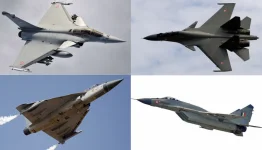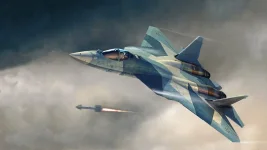- Views: 4K
- Replies: 4
India's acquisition of 272 Su-30MKI multirole fighter jets from Russia, starting in the late 1990s, significantly bolstered the Indian Air Force (IAF). Valued at roughly ₹55,000 crore (around $6 billion at the time), this agreement provided the IAF with what remains its primary combat aircraft, procured to counter potential threats from neighbouring China and Pakistan.
However, the structure of this major defence deal has provided critical lessons for India's future procurement strategies. The agreement involved assembling the majority of the aircraft in India by Hindustan Aeronautics Limited (HAL) using Russian-supplied kits. Crucially, it did not include a comprehensive transfer of technology (ToT) that would enable HAL to manufacture the jets independently.
This limitation, often referred to as the "Su-30 mistake," has led India to strongly emphasize complete technology transfer and domestic manufacturing in subsequent defence deals under the "Make in India" policy, aiming for genuine self-reliance and avoiding similar pitfalls.
The Su-30MKI agreement, initially signed in 1996 and later expanded, involved Russia's Sukhoi Design Bureau and Irkut Corporation. It was designed to supply 272 advanced fighters to replace India's older MiG-21 and MiG-27 fleets. While 50 initial aircraft came directly from Russia, HAL was tasked with assembling the remaining 222 in Nashik from kits.
The Su-30MKI, tailored for India with advanced avionics from France, Israel, and India itself, represented a major technological upgrade, featuring capabilities like thrust-vectoring engines and compatibility with missiles like the BrahMos.
The fundamental issue with the agreement was the absence of full technology transfer. While Russia provided licenses and technical documents for assembly, it retained the essential proprietary knowledge for manufacturing key components such as engines, radar systems, and the aircraft's structure.
Consequently, HAL's work was largely confined to putting together pre-made components. A 2015 report by the Comptroller and Auditor General (CAG) highlighted that by 2012, locally assembled Su-30MKIs cost ₹100 crore more per unit than imported ones, reaching ₹417 crore (about $55 million) each.
The CAG criticised the limited "indigenisation," noting that local content was only around 13% by value, far short of the anticipated 60%, and failed to cultivate deep manufacturing expertise within India.
Despite the Su-30MKI forming the backbone of the IAF with 14 operational squadrons, the lack of manufacturing know-how created long-term strategic disadvantages. India could not independently modify, innovate, or upgrade the platform effectively, limiting its ability to integrate newer systems or manage lifecycle costs efficiently.
Planned upgrades, such as the substantial ₹20,000 crore 'Super Sukhoi' enhancement package approved in 2024, still require Russian collaboration, increasing expenses.
Furthermore, geopolitical events, like Russia's annexation of Crimea in 2014 and the resulting international sanctions, disrupted the supply of essential spare parts, reportedly leading to significant portions of the Su-30 fleet being grounded at times, as noted by Jane's Defence Weekly in 2018.
This experience underscored the risks of prioritising immediate military capability over building long-term indigenous capacity. It contrasted sharply with China's approach, which involved partially reverse-engineering Russian aircraft like the Su-27 to develop its own J-11 and J-16 fighters, thereby strengthening its domestic aviation industry.
A retired IAF official was quoted in The Hindu on March 10, 2025, stating, "The Su-30 deal gave us a world-class fighter but chained us to Russia."
Learning from this, India initiated a significant shift in its defence procurement approach, spearheaded by the "Make in India" initiative launched in 2014. Current policies, outlined in the Defence Acquisition Procedure (DAP) 2020 and the Defence Procurement Manual (DPM), now strictly mandate significant ToT and local content for major defence acquisitions.
India's insistence now extends to demanding complete technology transfer, including design information, production processes, and crucial source codes for software.
Access to source codes is particularly vital as it allows India to independently integrate its own advanced weapons and systems onto foreign platforms without relying on the original manufacturer.
As Defence Minister Rajnath Singh stated at Aero India 2025, "No more Su-30 mistakes. Every defence deal must empower India to build its own future."
This stricter stance is evident in India's ongoing Multi-Role Fighter Aircraft (MRFA) tender for 114 new jets, where potential suppliers face rigorous ToT requirements.
The earlier 2016 deal for 36 Rafale jets from France included source code access for integrating Indian missiles but offered limited overall ToT, somewhat mirroring the Su-30 assembly model.
In contrast, Russia's offer for its Su-57E fighter at Aero India 2025 reportedly includes full ToT and co-production possibilities.
Proposals involving platforms like the US F-35 face challenges due to strict American policies limiting ToT and source code access, typically granted only to very close allies like Israel, as reported by Reuters on April 15, 2025.
India's focus on customising platforms with indigenous weapons, such as the next-generation BrahMos-NG and Astra missiles, makes access to source codes even more critical for seamless integration. While the Su-30MKI's design allowed for some such integration, the lack of deeper design expertise at HAL reportedly led to delays in upgrades.
Lessons learned are being applied to indigenous projects like the Advanced Medium Combat Aircraft (AMCA), India's fifth-generation fighter program, where the DRDO is prioritising the development of domestic radar, engine, and stealth technologies to minimise foreign dependence, according to an Economic Times report from April 5, 2025.
The "Su-30 mistake" has inadvertently spurred growth within India's defence industry, encouraging participation from the private sector alongside public sector undertakings.
Companies like Tata Advanced Systems and Mahindra Defence are now collaborating with global defence firms, while state-owned enterprises like Bharat Electronics Limited (BEL) are developing advanced indigenous systems.
Significant government funding, including ₹1.72 lakh crore for capital acquisition in the 2024-25 defence budget (total ₹6.22 lakh crore), supports this shift, with a high percentage of contracts reportedly awarded to Indian companies in recent years.
However, this pursuit of self-reliance faces hurdles. Demands for extensive ToT can deter foreign companies hesitant to share valuable proprietary technology.
Geopolitical factors, such as the risk of US sanctions under CAATSA impacting deals with Russia, and restrictions on sharing technology for platforms like the F-35, add complexity.
Furthermore, a 2024 CAG report cautioned that an excessive focus on ToT could potentially delay essential military procurements, a concern given the slow progress of the MRFA tender while regional adversaries advance their air power capabilities.
The lessons from the Su-30MKI deal remain highly relevant as India seeks to modernise its forces to counter advanced aircraft like China's J-20 and Pakistan's reported acquisitions.
Maintaining adequate squadron strength, which Air Chief Marshal V.R. Chaudhari noted in a 2025 interview could decline without new inductions, adds urgency to acquiring new capabilities while ensuring long-term strategic autonomy through robust indigenous defence manufacturing.
The key takeaway is the critical need for comprehensive technology transfer, including source codes, in future defence agreements to truly empower India's defence capabilities.



